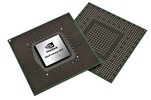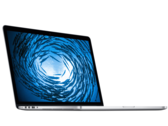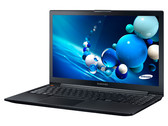
Dell XPS 15 Notebook Review
Intel Core i7-4712HQ | NVIDIA GeForce GT 750M | 15.60" | 2.1 kg

The NVIDIA GeForce GT 750M is a DirectX 11 graphics card of the middle class. It is based on the Kepler architecture and manufactured by TSMC in a 28-nanometer process. The GK107 chip (384 shaders) is clocked at up to 967 MHz plus boost and has a 128 bit memory interface (mostly DDR3, but GDDR5 also possible).
Architecture
The GK107 Kepler core offers two shader blocks, called SMX, each with 192 shaders for a total of 384 shader cores that are clocked at the same speed as the processor core. Although more shader cores are available in the Kepler architecture as compared to the Fermi design, the Kepler shaders are expected to be up to two times more power efficient. However, due to the missing hot clock of the shader domain, two shaders of a Kepler chip are as fast as one shader of a Fermi chip, even though Fermi shaders are clocked at twice the speed.
PCIe 3.0 is now supported by the mobile Kepler series and GPU Boost 2.0 can automatically overclock the card if the laptop cooling system allows it. This feature is available on any notebook with a graphics card of the 700M series.
Performance
Depending on clock speed, the GT 750M with DDR3 memory is about 10 - 15 percent faster than the GT 650M. The very rare GDDR5 version even beats the GTX 660M. Most current games (as of 2013) can be played fluently in high settings. In older titles, there are also reserves for additional quality features like AA and AF. Detailed benchmarks can be found further down on this page.
Features
The feature set includes support for up to 4 active displays. Furthermore, high resolution monitors of up to 3840x2160 pixels can now be connected using DisplayPort 1.2 or HDMI 1.4a if available. HD-Audio codecs, such as Dolby TrueHD and DTS-HD, can be transmitted via bitstream mode through the HDMI port. However, as most laptops will feature Optimus, the integrated GPU will likely have direct control over the display ports and may limit the feature set available by the Nvidia Kepler cards.
The 5th generation PureVideo HD video processor (VP5), also integrated in the GK107 core, offers hardware decoding of HD videos. Common codecs such as MPEG-1/2, MPEG-4 ASP, H.264 and VC1/WMV9 are fully supported up to 4K resolutions while VC1 and MPEG-4 are supported up to 1080p. Two streams can be decoded in parallel for features such as Picture-in-Picture. Another feature is the inclusion of a dedicated video encoding engine similar to Intel QuickSync that can be accessed via the NVENCI API.
Power Consumption
The power consumption of the GeForce GT 750M should be somewhere between the GT 650M and GTX 660M (about 35 - 40 watts). As a result, the Nvidia GPU is best suited for notebooks 15 inches in size or greater.
GeForce GT 700M Series
| ||||||||||||||||||||||||||||
| Codename | N14P-GT | |||||||||||||||||||||||||||
| Architecture | Kepler | |||||||||||||||||||||||||||
| Pipelines | 384 - unified | |||||||||||||||||||||||||||
| Core Speed | 967 MHz | |||||||||||||||||||||||||||
| Memory Speed | 2000 - 5000 MHz | |||||||||||||||||||||||||||
| Memory Bus Width | 128 Bit | |||||||||||||||||||||||||||
| Memory Type | DDR3, GDDR5 | |||||||||||||||||||||||||||
| Max. Amount of Memory | 4 GB | |||||||||||||||||||||||||||
| Shared Memory | no | |||||||||||||||||||||||||||
| API | DirectX 11, Shader 5.0 | |||||||||||||||||||||||||||
| Power Consumption | 35-40 Watt | |||||||||||||||||||||||||||
| Transistor Count | 1.3 Billion | |||||||||||||||||||||||||||
| technology | 28 nm | |||||||||||||||||||||||||||
| Features | Optimus, GPU Boost 2.0, PhysX, Verde Drivers, CUDA, 3D Vision, 3DTV Play | |||||||||||||||||||||||||||
| Notebook Size | medium sized | |||||||||||||||||||||||||||
| Date of Announcement | 01.04.2013 | |||||||||||||||||||||||||||
The following benchmarks stem from our benchmarks of review laptops. The performance depends on the used graphics memory, clock rate, processor, system settings, drivers, and operating systems. So the results don't have to be representative for all laptops with this GPU. For detailed information on the benchmark results, click on the fps number.































































For more games that might be playable and a list of all games and graphics cards visit our Gaming List



HP Envy 17-j110eg: Intel Core i7-4702MQ, 17.30", 3.4 kg
Review » Review HP Envy 17-j110eg Leap Motion Notebook
Dell Inspiron 7737 CN77304: Intel Core i7-4500U, 17.30", 3.3 kg
Review » Review Dell Inspiron 7737 CN77304 Notebook
Dell Inspiron 15-7537: Intel Core i7-4500U, 15.60", 2.6 kg
Review » Review Dell Inspiron 15-7537 Notebook
Acer Aspire R7-571G-53338G75ass: Intel Core i5-3337U, 15.60", 2.5 kg
Review » Review Acer Aspire R7-571G-53338G75ass Convertible
Acer Aspire V7-582PG-74508G52tkk: Intel Core i7-4500U, 15.60", 2.3 kg
Review » Review Acer Aspire V7-582PG-74508G52tkk Notebook
Acer Aspire V5-573G-54208G50aii : Intel Core i5-4200U, 15.60", 2 kg
Review » Review Acer Aspire V5-573G-54208G50aii Notebook
Asus N550JV-CN201H: Intel Core i7-4700HQ, 15.60", 2.7 kg
Review » Review Asus N550JV-CN201H Notebook
Asus N750JV-T4110H: Intel Core i7-4700HQ, 17.30", 3.3 kg
Review » Review Asus N750JV-T4110H Notebook
One K56-3F: Intel Core i7-4700MQ, 15.60", 2.6 kg
Review » Review One K56-3F (Clevo W650SR) Notebook
Asus N56VV-S4069H: Intel Core i7-3630QM, 15.60", 2.7 kg
External Review » Asus N56VV-S4069H
Dell XPS 15-9530-9002: Intel Core i7-4712HQ, 15.60", 2 kg
External Review » Dell XPS 15-9530-9002
Dell Inspiron 15 7537-7697: Intel Core i5-4200U, 15.60", 2.6 kg
External Review » Dell Inspiron 15 7537-7697
HP Envy 15-j151sr: Intel Core i7-4702MQ, 15.60", 2.6 kg
External Review » HP Envy 15-j151sr
Apple MacBook Pro Retina 15 inch Mid 2014: Intel Core i7-4870HQ, 15.40", 2 kg
External Review » Apple MacBook Pro Retina 15 inch Mid 2014
Acer Aspire V5-573PG-9610: Intel Core i7-4500U, 15.60", 2.2 kg
External Review » Acer Aspire V5-573PG-9610
Acer Aspire R7-572G-54208G1.02TASS: Intel Core i5-4200U, 15.60", 2.5 kg
External Review » Acer Aspire R7-572G-54208G1.02TASS
HP Envy 17-J004ER: Intel Core i7-4702MQ, 17.30", 2.9 kg
External Review » HP Envy 17-J004ER
HP Envy 17t-j100 Leap Motion: Intel Core i7-4702MQ, 17.30", 2.8 kg
External Review » HP Envy 17t-j100 Leap Motion
HP Envy 17-j100sr: Intel Core i7-4702MQ, 17.30", 3.4 kg
External Review » HP Envy 17-j100sr
Acer Aspire R7-582P: Intel Core i7-4500U, 15.60", 2.5 kg
External Review » Acer Aspire R7-582P
Asus N56VV-S4013H: Intel Core i5-3230M, 15.60", 3.2 kg
External Review » Asus N56VV-S4013H
Gigabyte U24T: Intel Core i7-4500U, 14.00", 1.8 kg
External Review » Gigabyte U24T
Dell XPS 15-9530: Intel Core i7-4702HQ, 15.60", 2 kg
External Review » Dell XPS 15-9530
Acer Aspire V7-582PG-54208G25TII: Intel Core i5-4200U, 15.60", 2.1 kg
External Review » Acer Aspire V7-582PG-54208G25TII
Dell XPS 15 Platinum: Intel Core i7-4702HQ, 15.60", 2 kg
External Review » Dell XPS 15 Platinum
MSI GE60-i750M245FD: Intel Core i7-4700MQ, 15.60", 2.6 kg
External Review » MSI GE60-i750M245FD
Acer Aspire R7-571G-7353121Tass: Intel Core i7-3537U, 15.60", 2.4 kg
External Review » Acer Aspire R7-571G-7353121Tass
Dell XPS 15 (Late 2013): Intel Core i7-4702HQ, 15.60", 2 kg
External Review » Dell XPS 15 (Late 2013)
Eurocom Electra: Intel Core i7-4700MQ, 15.60", 2.4 kg
External Review » Eurocom Electra
HP Envy 17-j110eg: Intel Core i7-4702MQ, 17.30", 3.4 kg
External Review » HP Envy 17-j110eg
Asus N750JV-T4110H: Intel Core i7-4700HQ, 17.30", 3.3 kg
External Review » Asus N750JV-T4110H
Acer Aspire V5-573G-54208G50aii : Intel Core i5-4200U, 15.60", 2 kg
External Review » Acer Aspire V5-573G-54208G50aii
Dell Inspiron 17-7737: Intel Core i5-4200U, 17.30", 3.2 kg
External Review » Dell Inspiron 17-7737
Dell Inspiron 7737 CN77304: Intel Core i7-4500U, 17.30", 3.3 kg
External Review » Dell Inspiron 7737 CN77304
Acer Aspire V7-482PG-6629: Intel Core i5-4200U, 14.00", 2.1 kg
External Review » Acer Aspire V7-482PG-6629
Apple MacBook Pro Retina 15 inch 2013-10: Intel Core i7-4850HQ, 15.40", 2 kg
External Review » Apple MacBook Pro Retina 15 inch 2013-10
Acer Aspire V7-582PG-74508G52tkk: Intel Core i7-4500U, 15.60", 2.3 kg
External Review » Acer Aspire V7-582PG-74508G52tkk
Dell Inspiron 15-7537: Intel Core i7-4500U, 15.60", 2.6 kg
External Review » Dell Inspiron 15-7537
Asus N550JV-CN253H: Intel Core i7-4700HQ, 15.60", 2.6 kg
External Review » Asus N550JV-CN253H
Asus N550JV-CN211D: Intel Core i7-4700HQ, 15.60", 2.4 kg
External Review » Asus N550JV-CN211D
Acer Aspire R7-571G-53338G75ass: Intel Core i5-3337U, 15.60", 2.5 kg
External Review » Acer Aspire R7-571G-53338G75ass
Asus N550JV-CN182H: Intel Core i7-4700HQ, 15.60", 2.6 kg
External Review » Asus N550JV-CN182H
Acer Aspire V5-473G-54204G50aii: Intel Core i5-4200U, 14.00", 1.8 kg
External Review » Acer Aspire V5-473G-54204G50aii
Asus N550JV-DB72T: Intel Core i7-4702HQ, 15.60", 2.7 kg
External Review » Asus N550JV-DB72T
Asus N550JV-CM067H: Intel Core i7-4700MQ, 15.60", 2.7 kg
External Review » Asus N550JV-CM067H
Acer Aspire V5-572G-73538G50akk: Intel Core i7-3537U, 15.60", 2.1 kg
External Review » Acer Aspire V5-572G-73538G50akk
Acer Aspire V7-582PG-7450121.02Ttkk: Intel Core i7-4500U, 15.60", 2.2 kg
External Review » Acer Aspire V7-582PG-7450121.02Ttkk
Asus N550JV-CN071H: Intel Core i7-4700HQ, 15.60", 2.7 kg
External Review » Asus N550JV-CN071H
Acer Aspire V7-482PG-9884: Intel Core i7-4500U, 14.00", 2 kg
External Review » Acer Aspire V7-482PG-9884
Acer Aspire V5-573PG-542012Taii: Intel Core i5-4200U, 15.60", 2.2 kg
External Review » Acer Aspire V5-573PG-542012Taii
Acer Aspire R7-571G-53338G1Tass: Intel Core i5-3337U, 15.60", 2.4 kg
External Review » Acer Aspire R7-571G-53338G1Tass
Acer Aspire V3-772G-747a8G1TMakk: Intel Core i7-4702MQ, 17.30", 3.2 kg
External Review » Acer Aspire V3-772G-747a8G1TMakk
Asus N550JV-CN027H: Intel Core i7-4700MQ, 15.60", 2.7 kg
External Review » Asus N550JV-CN027H
Alienware 14, GTX 750: Intel Core i7-4700MQ, 14.00", 2.8 kg
External Review » Alienware 14, GTX 750
Asus N750JV-T4109H: Intel Core i7-4700MQ, 17.30", 3.3 kg
External Review » Asus N750JV-T4109H
Acer Aspire V3-772G-747a121TBDWamm: Intel Core i7-4702HQ, 17.30", 3.2 kg
External Review » Acer Aspire V3-772G-747a121TBDWamm
Lenovo IdeaPad Y510p-59367273: Intel Core i7-4700MQ, 15.60", 2.7 kg
External Review » Lenovo IdeaPad Y510p-59367273
Acer Aspire V5-572G-53338G50akk: Intel Core i5-3337U, 15.60", 2 kg
External Review » Acer Aspire V5-572G-53338G50akk
Acer Aspire R7-571G-73538G25ass: Intel Core i7-3537U, 15.60", 2.5 kg
External Review » Acer Aspire R7-571G-73538G25ass
» Comparison of GPUs
Detailed list of all laptop GPUs sorted by class and performance.
» Benchmark List
Sort and restrict laptop GPUs based on performance in synthetic benchmarks.
» Notebook Gaming List
Playable games for each graphics card and their average FPS results.
* Approximate position of the graphics adapter
Top 10 Laptops
Multimedia, Budget Multimedia, Gaming, Budget Gaming, Lightweight Gaming, Business, Budget Office, Workstation, Subnotebooks, Ultrabooks, Chromebooks
under 300 USD/Euros, under 500 USD/Euros, 1,000 USD/Euros, for University Students, Best Displays
Top 10 Smartphones
Smartphones, Phablets, ≤6-inch, Camera Smartphones